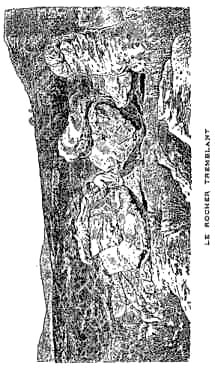Every year the ancient
town of Rhedae, or Rennes-le-Château as it is now called, sees an
increase in the number of excursionists who come to visit its
historic ruins - the ancient remains of days long past.
The Société d’Etudes scientifiques de l’Aude could therefore hardly
miss paying a visit to the town in order to search, in its turn, for
a new page to add to the history of our département. And so it was
that on 24 June, the day chosen for our excursion to Rennes-le-Château,
a goodly number of our members gathered at the ticket kiosks of the
railway station and, armed with their tickets, boarded the train in
high spirits.
6. 15 a. m. : the heavy mass of the train rattled and shook, station
followed station. . . At the railway station in Alet one of our
colleagues, Monsieur Deville, the Mayor of that delightful town,
joined the party. A few minutes later we were in Couiza. We were in
quite a hurry to get out of the train, as the day promised to be
very hot and it was important to make the climb to Rennes-le-Château
before the heat became too intense. At Couiza two new colleagues
joined our party, which was already of a very respectable size. The
little group set off on foot, admiring in passing the castle of
Couiza, the former seat of the Dukes of Joyeuse, built around 1640
on the banks of the Aude and the Sals.
We could already see - to our right and on the heights - the ancient
towers of the Castle of Rennes, but it was an hour’s walk before we
reached the ancient capital of Rhedesium. And so we climbed the
slope, sometimes preceded, sometimes followed by a small donkey that
carried our bags for us. We could not help noticing that the
botanists amongst us were already completely absorbed in their
researches.
9. 30 a. m. : at last we reached the summit. By now it was very hot,
but at this altitude (435 metres above sea level) the air was still
fresh. On our journey up we noted the ancient surrounding-walls or
fortifications, of which only a few sections still remained. Storing
our baggage in a safe place we began immediately with a visit to the
Castle. Here, save for some large high-ceilinged apartments, there
was nothing very remarkable to catch the eye; everything was old,
decayed and, above all, dilapidated. Some of the rooms were still
habitable, however, and, indeed, were being occupied by our luncheon
host. So our visit was a very brief one.
Following a narrow, twisting road we arrived at the property of
Monsieur Auguste Fons, who had recently discovered an ossuary at the
foot of the ancient ramparts of the fortress. And it was certainly
quite an ossuary that was shown to us! One of our number, armed with
a pick, tried digging in order to determine the thickness of the
layer of accumulated remains, but tibia followed tibia and skulls
jostled for space with a simply incalculable number of femurs -
finally, weary from the struggle, we decided to leave this gruesome
place.
Standing on top of a tower of recent construction we were able to
admire the beautiful panorama which unfolded before our eyes. To our
left was the great plain of Lauzet with, in the distance, the
village of Granès and, further to the right, Saint-Ferriol. A little
nearer, straight ahead of us, there seemed to rise on a small hill
the fortress that defended the town of Rennes-le-Château. Hence the
name of the hill: ’Le Casteillas’. But nothing survived there and it
was impossible for the visitor to find any trace of any structures
having been there.
We saw the river Aude winding through the village of Campagne. There
was Espéraza with its high chimneys, an important centre for the
manufacture of woollen bonnets. Further on was the village of Fa
with its ancient tower, known as ’Le tour des signaux’ (’the signal
tower’). There was Antugnac, Montazels and Couiza with, even further
to the right, Coustaussa and its ruined castle. But time was getting
on and regretfully we had to leave our observation post and continue
our visit.
The Church (1740) soon loomed ahead of us. The interior was superb,
with attractive paintings exuding freshness and charm. We looked for
some signs of the past there, but in vain. But in a small garden
adjoining the church one of us recognised a crudely sculpted (or
rather engraved) tombstone as dating from the 5th century; it was
unfortunate that this tombstone was being used as a step of a
staircase and was therefore exposed to all the inclemencies of the
open air. It would have been better if it had been placed inside the
church where it could with advantage have taken the place of some
varnished or gilded panel or other.
We also noted, in another small garden, a stone plinth supporting a
statue of the Virgin. This plinth, very old and of beautiful
workmanship, had been retouched on the pretext of giving it a higher
relief: on the contrary, in doing so the workman had deprived it of
any trace of artistry and had destroyed the preciousness of this
ancient piece of sculpture.
A visit to the cemetery enabled us to discover, in a corner, a wide
tombstone, broken in the middle, on which one could read a very
crudely engraved inscription.
This tombstone measured 1. 30 metres by 0. 65 metres.

‘Here lies the noble
Marie de Nègre D’Arles, La Dame d’Hautpoul de Blanchefort, aged
sixty-seven, died 17 January 1781, May she rest in peace’
But then someone came to remind us that it was time for lunch, which
was served in one of the rooms of the Castle. The meal was certainly
of the better standard. An excellent mocha rounded off the
festivities and the first part of our programme. We thanked M.
Auguste Fons for his hospitality and, at the suggestion of M. Fages,
elected him a member of the Society to a round of applause.
Now it was time to leave Rennes-le-Château, but we did not fail to
notice as we left it that the important town of yesteryear had given
way to a village of antiquated, small and badly constructed houses:
some of them - their owners now dead - were even going to rack and
ruin.
The two villages of Rennes-le-Château and Rennes-les-Bains are not
connected by any roads which vehicles can use: rough paths serving
rather for the running of a small farm are the only thoroughfares.
Taking one of these paths we followed it as far as the small farm
known as ’Les Paliacés’ before plunging across the fields, as we
needed to reach the ’Pla de la Côte’, where the so-called ’Rocher
Tremblant’ (’the trembling rock’) was located. Once we arrived
there, twenty strong arms embraced the famous rock, which, we
thought, must surely tumble over with the tremendous force being
exerted upon it, but the huge mass did not even budge - or, at
least, hardly at all. To see the number of inscriptions, names and
dates scratched onto the stone one could readily imagine the vast
numbers of tourists who had come here to find out how strong they
really were.

A narrow path soon
brought us to Tiffou Mill. Some minutes’ pause was necessary to
enable us to smarten up. Finally we were back at Les Bains de Rennes.
The summer sees the arrival there of huge numbers of people - to
drink the waters or to bathe in them. What in winter is just a small
village suddenly finds itself transformed into a charming and
bustling small town. We noted that a large number of these bathers
had already arrived for the sake of their health. What we needed at
that moment was, first of all, some shade - as it was still very hot
- some rest for our weary limbs and, above all, some refreshments.
We found all these things on the terrace of the Café Cadenat.
But already our coachmen
were harnessing their horses to take us back to Couiza. Leaving our
shady terrace with regret we paid a quick visit to some of the
bathing establishments, so quick in fact that it is impossible to
give any precise details about their modern comforts. ’All aboard -
quickly please’, came the cry. Our horses, now well rested, wanted
only to return to Couiza, and they took us there at a lively pace.
Here the town was en fête and the musicians, seated along the Route
Nationale in the shade of fresh plane trees, were sending the
strains of the choicest items from their repertoire into the summer
air. After a snack at Monsieur Igounet’s we walked to the railway
station. The train whistled, then began to move - and we were off!
All in all, a very worthwhile and pleasant day.
E. TISSEYRE.